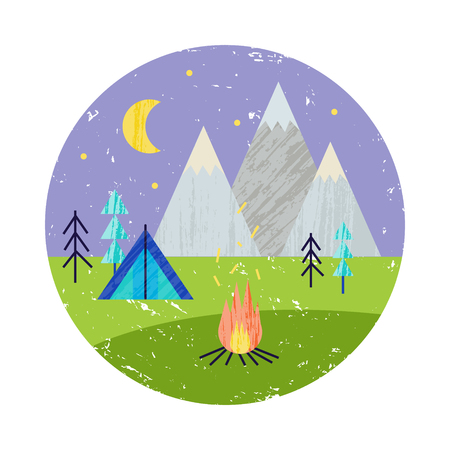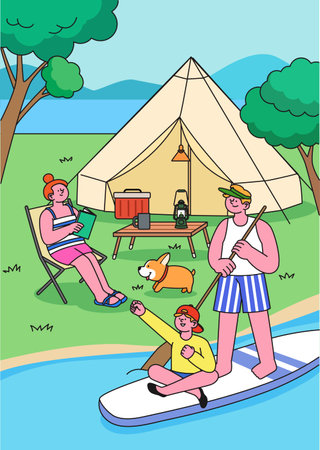Understanding Spring Weather Patterns
Spring is one of the most exciting seasons to go camping, but its also one of the most unpredictable when it comes to weather. Across different regions of the U.S., spring can bring a mix of sunshine, sudden rainstorms, gusty winds, and even late-season snow. Knowing what to expect from the weather in your area—or wherever youre heading—is key to staying safe and comfortable on your trip.
Regional Differences in Spring Weather
The U.S. is huge, and spring weather varies greatly depending on where you are. Heres a quick breakdown of what you might face in different parts of the country:
| Region | Common Spring Weather Challenges |
|---|---|
| Northeast | Cold nights, muddy trails, surprise snowstorms |
| Southeast | Thunderstorms, heavy rain, high humidity |
| Midwest | Tornadoes, temperature swings, strong winds |
| Southwest | Dry conditions, sudden cold fronts at night |
| Northwest | Frequent rain, chilly mornings, cloud cover |
| Mountain Regions (Rockies, Sierra Nevada) | Late-season snow, rapidly changing temps, icy trails |
Why Spring Is So Unpredictable
The main reason spring weather can be so all over the place is because its a transitional season. Cold air masses from winter still linger while warm air from summer starts moving in. When these collide, they create unstable weather patterns like storms or sudden drops in temperature.
Watch for These Common Spring Hazards:
- Sudden Temperature Drops: It might be 70°F during the day but dip into the 30s at night.
- Heavy Rainfall: Flash flooding or muddy campsites can make for tough conditions.
- Wind Gusts: Strong spring winds can knock over tents or cause falling branches.
- Snowfall in Higher Elevations: Don’t be surprised if you wake up to snow—even in April or May.
Tip:
If youre unsure about the climate of your camping destination, check local park websites or use apps like NOAA Weather Radar or AccuWeather for up-to-date forecasts and alerts before and during your trip.
2. Choosing the Right Campsite
Picking the right campsite in spring is more than just finding a pretty spot — it’s about staying safe and dry when Mother Nature throws a curveball. Spring weather can be unpredictable, with sudden rainstorms, melting snow, and strong winds. That’s why it’s important to choose your campsite carefully to avoid risks like flooding or falling branches.
Consider Elevation
When choosing a place to pitch your tent, look for higher ground. Camping in low-lying areas can lead to trouble if it rains heavily — water tends to collect in valleys and dips, which can flood your tent overnight. A slightly elevated site will help you stay dry and comfortable.
Check the Drainage
A flat area might seem ideal at first glance, but poor drainage can leave you sleeping in a puddle. Look for spots with natural slopes that allow water to run off easily. Avoid areas with thick mud or standing water — these are signs of poor drainage and potential flooding risks.
Watch Out for Overhead Hazards
Spring storms often bring strong winds that can break tree branches. Set up camp away from dead or leaning trees, and check above your tent area for any loose or cracked limbs that could fall. These are often called “widowmakers” for a reason — they’re dangerous.
Quick Checklist for Safe Campsite Selection
| Factor | What to Look For | Why It Matters |
|---|---|---|
| Elevation | Slightly higher ground | Prevents flooding during rain |
| Drainage | Naturally sloped terrain, no puddles | Keeps your tent dry and mud-free |
| Trees & Branches | No dead or hanging limbs above | Avoids injury from falling branches during wind |
| Wind Exposure | Sheltered from direct wind (like behind bushes or rocks) | Reduces tent damage and heat loss on chilly nights |
| Proximity to Water | Not too close to rivers or streams | Avoids rising water levels and attracts fewer bugs |
Think About Accessibility & Emergency Exit Routes
If weather conditions worsen, you’ll want a campsite that allows for a quick exit if needed. Stay within reasonable distance of marked trails or access roads. Make sure you have a clear path out in case of heavy rain or other emergencies.
Pro Tip:
Before setting up camp, take a few minutes to walk around the area after arriving. Check how wet the ground feels, look for signs of recent flooding (like debris lines), and listen for running water nearby. These small steps can make a big difference in your comfort and safety.

3. Essential Gear for Spring Camping
Spring camping brings the excitement of nature waking up after winter, but it also comes with unpredictable weather conditions. To stay safe and comfortable, its important to pack gear that can handle everything from chilly mornings to unexpected rain showers. Here’s a breakdown of must-have spring-specific camping gear.
Waterproof Clothing
Rain is a common guest during spring trips. Make sure to bring waterproof jackets and pants that are both breathable and durable. Look for features like adjustable hoods, taped seams, and ventilation zippers to stay dry without overheating.
Layering System
Spring temperatures can swing wildly throughout the day. A smart layering system helps you adapt easily:
| Layer | Purpose | Recommended Materials |
|---|---|---|
| Base Layer | Wicks moisture away from your skin | Synthetic or Merino Wool |
| Mid Layer | Provides insulation and retains heat | Fleece or Lightweight Down |
| Outer Layer | Shields against wind and rain | Waterproof/Breathable Shell (Gore-Tex, etc.) |
Four-Season Tent
A sturdy tent is crucial for handling springs unpredictable weather. While three-season tents may work in mild conditions, a four-season tent offers better protection from strong winds, heavy rain, and even late snowfall. Choose one with a full-coverage rainfly and strong poles.
Synthetic Sleeping Bag
Damp conditions are common in spring, making synthetic sleeping bags a smarter choice over down bags. Synthetic insulation retains warmth even when wet and dries faster, which is important if your gear gets exposed to moisture.
Packing Checklist for Spring Weather Preparedness
| Gear Item | Why It Matters in Spring |
|---|---|
| Waterproof Jacket & Pants | Keeps you dry during sudden showers or storms |
| Synthetic Sleeping Bag (rated for 20°F/-6°C) | Stays warm even when damp; handles cold nights well |
| Four-Season Tent with Rainfly & Footprint | Handles wind, rain, and possible late snowfalls |
| Layered Clothing System (base, mid, outer) | Easily adjust to temperature changes throughout the day |
| Waterproof Hiking Boots & Extra Socks | Mud and puddles are common; dry feet prevent blisters and discomfort |
Packing the right gear tailored for spring conditions can make or break your outdoor adventure. Being prepared means you’ll stay safe, dry, and warm—even when Mother Nature throws a curveball.
4. Monitoring Weather Forecasts and Alerts
When youre planning a spring camping trip, keeping an eye on the weather isnt just helpful—it’s essential. Spring weather can be unpredictable, with sudden rain showers, thunderstorms, or even late-season snow. Knowing how to monitor forecasts and receive alerts can make all the difference in staying safe and making smart choices during your outdoor adventure.
Using Weather Apps
Weather apps are one of the easiest ways to stay updated. Many free and paid apps offer real-time weather updates, radar maps, and storm tracking features. Here are a few popular options used by campers across the U.S.:
| App Name | Main Features | Why Campers Like It |
|---|---|---|
| The Weather Channel | Hourly & 10-day forecasts, radar, severe weather alerts | User-friendly interface and reliable predictions |
| AccuWeather | Minute-by-minute precipitation forecast (MinuteCast) | Great for tracking rain when youre setting up camp |
| MyRadar | Live radar with customizable layers | Ideal for visualizing incoming storms quickly |
Tuning In to NOAA Alerts
The National Oceanic and Atmospheric Administration (NOAA) provides accurate and timely weather warnings through their NOAA Weather Radio service. These alerts are especially useful in remote areas where cell service may be spotty. Consider carrying a portable NOAA weather radio or downloading a NOAA-supported app that can send push notifications directly to your phone.
Types of NOAA Alerts You Should Know:
- Severe Thunderstorm Watch/Warning: Indicates conditions are favorable or a storm is occurring
- Tornado Watch/Warning: Be prepared or take cover immediately if a warning is issued
- Flash Flood Warning: Avoid low-lying areas and seek higher ground immediately
Check Local News Before You Go
Before heading out, tune into local news stations for region-specific forecasts. They often provide more detailed information about microclimates or unique hazards in certain parks or camping areas. Many local stations also have their own apps or social media feeds where they post real-time updates.
Helpful Tip:
If you’re camping near mountains or rivers, keep in mind that weather can change rapidly and vary greatly from nearby towns. Always assume that higher elevations will be colder and more prone to sudden storms.
By using the right tools and checking multiple sources for weather information, you’ll be better prepared for whatever spring throws your way—making your camping trip safer and more enjoyable.
5. Emergency Preparedness and Safety Tips
Spring weather can be unpredictable, especially when youre out camping. From sudden thunderstorms to unexpected cold snaps, being ready for emergencies is key to staying safe. Heres how you can prepare for extreme weather and other potential issues while camping in the spring.
Create an Emergency Plan
Before heading out, make a simple plan that everyone in your group understands. Discuss what to do if someone gets lost, where to meet up in case of separation, and how to contact emergency services. It’s also smart to research the nearest hospital or ranger station near your campsite.
What Your Emergency Plan Should Include:
| Item | Details |
|---|---|
| Meeting Point | A designated spot where everyone meets if separated |
| Emergency Contacts | List of phone numbers for family, park rangers, and local hospitals |
| Weather Alerts | Have a way to receive NOAA weather alerts (radio or app) |
| Shelter Plan | Know where to take shelter during a storm or extreme weather event |
Pack a First-Aid Kit
A well-stocked first-aid kit is essential for any camping trip. In spring, when allergies and wet conditions are common, it’s important to be extra prepared.
Basic First-Aid Kit Checklist:
- Bandages (various sizes)
- Antibiotic ointment
- Pain relievers (ibuprofen or acetaminophen)
- Tweezers and scissors
- Allergy medication (like antihistamines)
- Hydrocortisone cream for bug bites or rashes
- Thermometer
- Emergency blanket
- Personal medications with instructions
Know When to Evacuate or Seek Shelter
If the weather turns dangerous — like high winds, lightning, flash floods, or hail — it’s time to act quickly. Don’t wait until it’s too late. Trust your instincts and get to a safe place.
Signs Its Time to Evacuate:
- You see dark, fast-moving clouds or hear thunder in the distance.
- Your area is under a flood watch or warning.
- The wind becomes strong enough to threaten tents or trees nearby.
- You’re receiving weather alerts advising immediate action.
If youre staying in a campground with facilities, head to the nearest building or designated storm shelter. If youre backcountry camping, look for low-lying areas away from tall trees and ridges — but avoid valleys that could flood. Always keep your gear packed light so you can move fast if needed.
By planning ahead and knowing what to do in an emergency, you’ll have peace of mind — and more fun — during your spring camping adventure.

